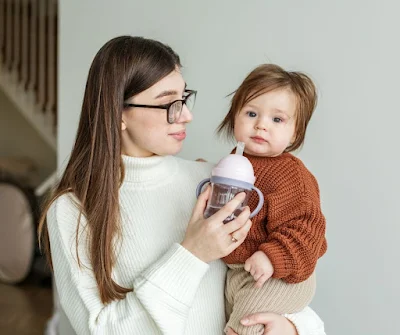How to wean a toddler from bottle feeding
Bottle feeding a baby is a time-consuming and stressful task. You must monitor your milk production, your baby's feeding schedule, and other factors. Once you start weaning your toddler from the bottle, it can be equally as stressful—but for very different reasons! Some mothers feel bad about denying their toddlers something they adore so much, while others worry that if a bottle isn't around at all times, their children won't get enough food or liquids.
What
if, then, I could prove to you that things don't have to be this way? That
there are actually ways to help you through the process?
Be consistent
While
consistency is important for all aspects of parenting, it's especially
important when weaning a toddler from bottle feeding.
While
your child may be ready to make the transition, she might not want to let go of
her beloved bottle—and that's okay! Be patient and don't give up hope if it
takes your child a few days or weeks to adjust.
The
easiest way for kids to learn how much milk they need each day is through their
bottles. Just like with food portions, if you're inconsistent with the amount
of milk in your child's bottles, she won't know what she needs each day—so be
consistent!
Here are some ways you can be consistent while weaning:
Consistency
with your child's routine—always give her an extra-long bedtime story before
bedtime (no matter what time) and make sure there are no disruptions during
naptime on weekdays. This will help her feel secure and help her transition
into a new routine without feeling anxious or stressed out by changes in
schedule structure or environment setup.
Consistency
with weaning methods—don't expect too much from yourself at first; once you
feel comfortable doing so consistently over time then gradually increase how
many times per week/day/monthly etc., depending on how quickly things improve
for everyone involved.
Be patient
The
process of weaning your toddler from the bottle can be a long one. It may take
several days, weeks, or even months to achieve your goal. Be patient with
yourself, and especially with your child. This is not something that should be
rushed through; it's important for everyone to feel comfortable during this
time of change.
Be
patient with both yourself and your toddler if they don't make any significant
progress in the first few weeks or even months (this isn't unusual).
Be patient with yourself as well—don't get discouraged if things don't work out exactly as you'd planned them. Celebrate each small victory (and there will be many!), whether that's getting through a week without any accidents or having an entire meal without needing to give out the bottle at all!
You
might need more than just patience though; sometimes it takes more than that:
some children will really struggle at first when they're given their own cup
rather than having something warm and fuzzy in their mouth all day long (it
sounds weird but there are lots of studies on this!). You could consider buying
some specialized sippy cups which have special valves so liquids won't leak out
everywhere when tipped over accidentally by an excited toddler trying to drink
from them too fast!
Pick a weaning method that makes sense for you
When
it comes to weaning a toddler, you should pick a method that makes sense for
you. One mom might find that the slow weaning method works best, while another
may prefer the cold turkey approach. It all depends on your personal
preferences and what will work best in your family situation.
If
you're new to motherhood, remember: there are no right or wrong answers when it
comes to parenting! Just do what's right for YOU and YOUR CHILD.
Once the bottle is gone, be prepared for backsliding
Once
the bottle is gone, be prepared for backsliding. It's not uncommon for toddlers
to go back to the bottle after they've been successful with other methods of
feeding. This is normal and doesn't mean that you've done anything wrong—it
just means that your child needs more time to adjust to weaning. But don't
worry! You can keep this in mind and make sure you're sensitive to your child's
needs when it comes time for them (or you) to move forward again
Don't forget about nighttime feedings or naps
Don't
expect to be done with bottles in a week or two. As long as your little one is
taking a bottle, you'll need to find alternatives for them at night, when
they're away from home (if you get it in the car, on their stroller or high
chair), and any time they wake up at night crying out for milk.
Try
transitioning from bottle to sippy cup if possible! The sooner he gets used to
drinking out of one of these pieces of equipment instead of a bottle, the
easier it will be on all parties involved—and remember: don't push him into
trying something new if he's not ready! Let him build up his excitement by
showing off his new cup at first before letting him try eating anything with it
so he can enjoy playing around with it without feeling pressured by mealtimes
just yet!





Comments
Post a Comment